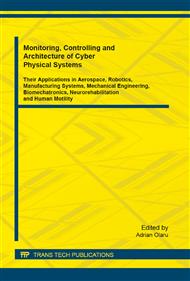[1]
G. Moorthy, Dr. H.N. Narasimha Murthy and Dr. M. Krishna, finite element analysis of grid stiffened composite structure of under water vehicle, International Journal of Advanced Engineering Research and Studies, Vol. II, Issue I, October-December, 2012, 151-153.
Google Scholar
[2]
Graham D. Buckling of thick-section composite pressure hulls. Compos Struct 1996; 35: 5–20.
DOI: 10.1016/0263-8223(96)00020-7
Google Scholar
[3]
Ossc TJ, Lee TJ. Composite pressure hulls for autonomous underwater vehicles. In: IEEE oceans conference record, Vancouver, BC, Canada, 29, September 4, October 2007. No. 4449124.
Google Scholar
[4]
Ross CTF. A conceptual design of an underwater vehicle, Ocean Engineering, 2006; 33: 2087–2104.
DOI: 10.1016/j.oceaneng.2005.11.005
Google Scholar
[5]
Joung T H, Lee C M, Hong S W, Kim J B, An C W, A study on the results of the pressure vessel design. Structural analysis and pressure test of the semiautonomous underwater vehicle (SAUV), Korean Society of Ocean Engineering, 2004; 18: 52–58.
Google Scholar
[6]
Carvelli V, Panzeri N, Poggi C. Buckling strength of GFRP under-water vehicles. Composites: Part B 2001; 32: 89–101.
DOI: 10.1016/s1359-8368(00)00063-9
Google Scholar
[7]
Messager T, Pyrz M, Gineste B, Chauchot P. Optimal laminations of thin underwater composite cylindrical vessels. Compos Struct 2002; 58: 529–37.
DOI: 10.1016/s0263-8223(02)00162-9
Google Scholar
[8]
Ng RKH, Yousefpour A, Uyema M, Ghasemi Nejhad MN. Design, analysis, manufacture, and test of shallow water pressure vessels using e-glass/epoxy woven composite material for a semi-autonomous underwater vehicle. J Compos Mater 2002; 36(21): 2443–78.
DOI: 10.1177/0021998302036021972
Google Scholar
[9]
Graham D. Buckling of thick-section composite pressure hulls. Compos Struct 1996; 35: 5–20.
DOI: 10.1016/0263-8223(96)00020-7
Google Scholar
[10]
Hahn H T, Jensen D W, Claus S J. Structural Design Criteria for filament wound composite shells, NASA CR195125, (1994).
Google Scholar
[11]
ChulJin Moon, In-Hoon Kim, Bae-Hyeon Choi, Jin-Hwe Kweon , Jin-Ho Choi, Buckling of filament-wound composite cylinders subjected to hydrostatic pressure for underwater vehicle applications, Composite Structures, 2010; 92: 2241–2251.
DOI: 10.1016/j.compstruct.2009.08.005
Google Scholar
[12]
Seong-Hwa Hur, Hee-Jin Son, Jin-Hwe Kweon, Jin-Ho Choi, Postbuckling of composite cylinders under external hydrostatic pressure, Composite Structures, 2008; 86: 114–124.
DOI: 10.1016/j.compstruct.2008.03.028
Google Scholar
[13]
Hur SH, Son HJ, Kweon JH, Choi JH. Postbuckling of composite cylinders under external hydrostatic pressure. Compos Struct 2008; 86: 114–24.
DOI: 10.1016/j.compstruct.2008.03.028
Google Scholar
[14]
Jackson D, Dixon M, Shepherd B, Kebadze E, Lummus J, Crews M, et al. Ultra-deepwater carbon fiber composite pressure vessel development, dualelement buoyancy unit (DEBU). SAMPE J 2007; 43: 61–70.
Google Scholar
[15]
Han JY, Jung HY, Cho JR, Choi JH, Bae WB. Buckling analysis and test of composite shells under hydrostatic pressure. J Mater Process Technol 2008; 201: 742–5.
DOI: 10.1016/j.jmatprotec.2007.11.228
Google Scholar


